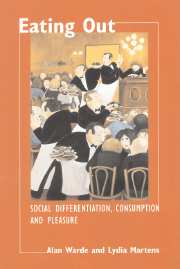Book contents
1 - Studying eating out
Published online by Cambridge University Press: 22 September 2009
Summary
There has been an explosion of social scientific interest in food in the last decade. Nutritionists, social policy advisors, anthropologists, agricultural economists and historians have always studied food habits, though for different reasons. However, before the 1990s general social scientific interest in the practical, social and cultural aspects of food was minimal. For a sociologist, the field consisted of a stuttering debate on the nature of the proper meal and its role in domestic organisation (e.g. Douglas, 1975; Douglas and Nicod, 1974; Murcott, 1983a and 1983b; Charles and Kerr, 1988), a few occasional essays on exceptional behaviour like vegetarianism, health food shopping and children's sweets (Twigg, 1983; Atkinson, 1980; and James, 1990, respectively), and Mennell's (1985) major, largely neglected, historical comparison of the development of food habits in Britain and France. This situation had changed markedly by the time of writing, with the publication of a series of literature surveys and textbooks (e.g. Beardsworth and Kiel, 1997; Bell and Valentine, 1997; Mennell et al., 1992; Wood, 1995) and of research monographs and essays (Caplan, 1997; Fine et al., 1996; Lupton, 1996; Marshall, 1995; Murcott, 1998; Warde, 1997).
One indicator of the growth of interest in food was the Economic and Social Research Council's programme ‘The Nation's Diet: the social science of food choice’, which began in 1992. We undertook one of the sixteen projects.
- Type
- Chapter
- Information
- Eating OutSocial Differentiation, Consumption and Pleasure, pp. 1 - 16Publisher: Cambridge University PressPrint publication year: 2000

